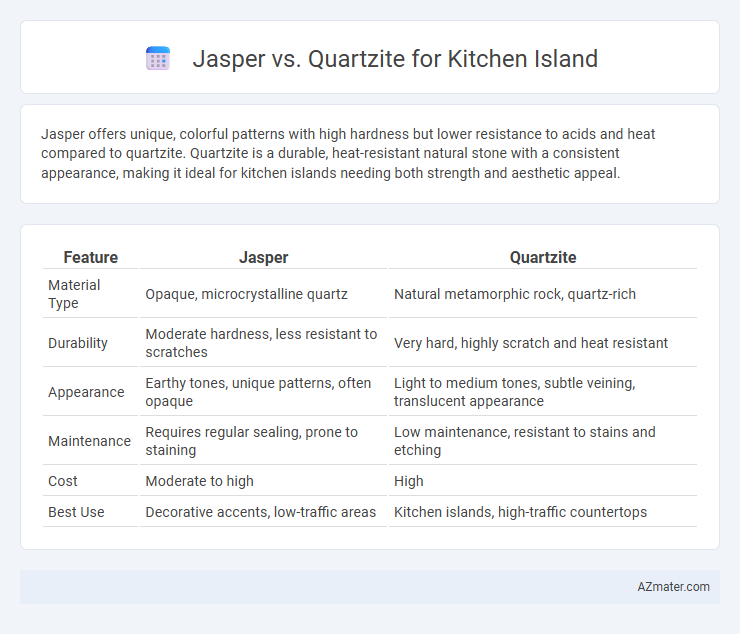Jasper offers unique, colorful patterns with high hardness but lower resistance to acids and heat compared to quartzite. Quartzite is a durable, heat-resistant natural stone with a consistent appearance, making it ideal for kitchen islands needing both strength and aesthetic appeal.
Table of Comparison
| Feature | Jasper | Quartzite |
|---|---|---|
| Material Type | Opaque, microcrystalline quartz | Natural metamorphic rock, quartz-rich |
| Durability | Moderate hardness, less resistant to scratches | Very hard, highly scratch and heat resistant |
| Appearance | Earthy tones, unique patterns, often opaque | Light to medium tones, subtle veining, translucent appearance |
| Maintenance | Requires regular sealing, prone to staining | Low maintenance, resistant to stains and etching |
| Cost | Moderate to high | High |
| Best Use | Decorative accents, low-traffic areas | Kitchen islands, high-traffic countertops |
Introduction: Jasper vs Quartzite for Kitchen Islands
Jasper and quartzite are both popular natural stones used for kitchen islands, valued for their durability and aesthetic appeal. Jasper offers rich, earthy tones with intricate patterns, making it ideal for creating a unique focal point in kitchen design. Quartzite provides exceptional hardness and resistance to heat and scratches, ensuring long-lasting beauty and functionality in high-traffic kitchen areas.
Overview of Jasper and Quartzite
Jasper is a durable, opaque variety of chalcedony known for its rich, earthy colors and unique patterns, making it a popular choice for kitchen islands that demand both strength and aesthetic appeal. Quartzite, a natural metamorphic rock primarily composed of quartz, offers exceptional hardness and resistance to heat and scratches, combining natural beauty with practicality in kitchen spaces. Both materials provide robust surfaces, but quartzite typically offers superior durability and a more consistent appearance compared to jasper's varied, artistic look.
Appearance: Color and Pattern Differences
Jasper showcases a rich variety of vibrant colors ranging from deep reds and greens to golden yellows, often displaying intricate, earthy patterns with a natural, opaque finish. Quartzite typically features a more neutral palette dominated by whites, grays, and soft beiges, characterized by a crystalline, marble-like appearance with subtle veining. The bold, dynamic colors and patterns of jasper provide a statement piece for kitchen islands, while quartzite offers a sophisticated, timeless elegance with its light, translucent qualities.
Durability and Hardness Comparison
Jasper, a dense and durable form of chalcedony, offers excellent resistance to scratches and chips, making it a reliable choice for kitchen islands in high-traffic areas. Quartzite, a natural metamorphic rock composed primarily of quartz, ranks higher on the Mohs hardness scale, typically between 7 and 8, providing superior hardness and resistance to abrasion and heat. While both materials are durable, quartzite's enhanced hardness and heat resistance make it a more robust option for kitchen islands subjected to heavy use and hot cookware.
Maintenance and Upkeep Requirements
Jasper requires minimal maintenance due to its dense and non-porous nature, resisting stains and scratches effectively, making it ideal for busy kitchen islands. Quartzite, while durable and heat-resistant, demands regular sealing to prevent staining and etching from acidic substances, ensuring longevity in high-traffic areas. Both stones offer excellent durability, but Jasper's low upkeep makes it preferable for homeowners seeking hassle-free kitchen island surfaces.
Cost and Affordability
Jasper typically costs between $5 to $30 per square foot, making it a more affordable option for kitchen islands compared to quartzite, which ranges from $60 to $100 per square foot due to its natural stone durability. Jasper's lower price point is ideal for budget-conscious homeowners seeking aesthetic appeal without compromising on style. Quartzite offers superior hardness and resistance to staining, justifying its higher investment for long-term kitchen island use.
Heat and Stain Resistance
Jasper offers moderate heat resistance but is more porous, making it prone to staining without proper sealing, which requires regular maintenance to preserve its appearance on kitchen islands. Quartzite provides superior heat resistance and excels in stain resistance due to its natural hardness and low porosity, ensuring durability against hot pots and everyday spills. Choosing quartzite for a kitchen island delivers a more resilient surface with less risk of heat damage and staining compared to jasper.
Environmental Impact and Sustainability
Jasper, a natural gemstone, is quarried with relatively low energy consumption but is less commonly used in kitchen islands, resulting in limited large-scale environmental data. Quartzite, a natural metamorphic rock, often requires intense mining and processing, which can produce significant carbon emissions and habitat disruption; however, it is highly durable and long-lasting, reducing the need for replacement. Choosing locally sourced materials and certified sustainable quarrying practices improves the environmental impact of both Jasper and Quartzite for kitchen island applications.
Popular Design Applications
Jasper and quartzite both offer unique aesthetic qualities for kitchen islands, with jasper known for its vibrant, multicolored patterns that create a bold and artistic focal point. Quartzite provides a more subtle, natural stone look with high durability and resistance to heat, making it ideal for functional kitchen surfaces. Popular design applications include jasper for statement islands in contemporary or eclectic kitchens, while quartzite is favored in modern, rustic, or classic designs for a timeless, elegant appeal.
Which Is Better for Your Kitchen Island?
Quartzite offers superior durability and resistance to heat, making it an excellent choice for kitchen islands subjected to heavy use. Jasper, a form of chalcedony, provides unique, vibrant patterns but is generally softer and more prone to scratches compared to quartzite. For a kitchen island, quartzite's hardness and low maintenance make it a better option for longevity and sustained beauty.

Infographic: Jasper vs Quartzite for Kitchen Island
 azmater.com
azmater.com